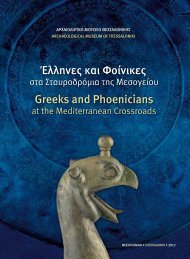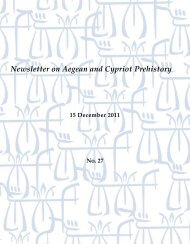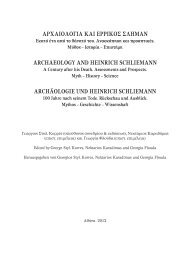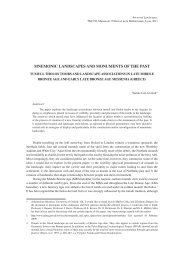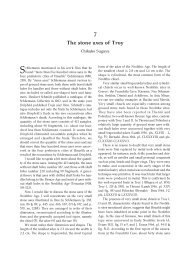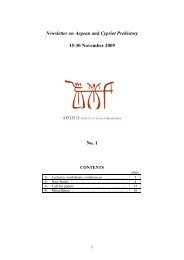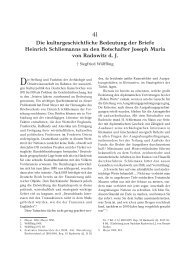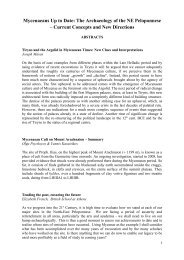You also want an ePaper? Increase the reach of your titles
YUMPU automatically turns print PDFs into web optimized ePapers that Google loves.
524 Hara S. Georgiou<br />
terminates directly on or behind the gunwale <strong>and</strong> is<br />
thus not differentiated.<br />
Ships with two yards occur in Minoan glyptic as<br />
early as the MM II period. 8 In the case of rigging with<br />
two yards, the archaeological <strong>and</strong> textual sources differ<br />
from each other. There is no reference to this system<br />
in Homer. A single yard is described. 9 The single<br />
yard is preferred during <strong>and</strong> subsequent to the <strong>Bronze</strong><br />
<strong>Age</strong>.<br />
Some observations about the <strong>sailing</strong> ship are possible<br />
despite the lacunae in the painting. 10 The lines<br />
are insufficient to h<strong>and</strong>le the rigging needed for a<br />
<strong>sailing</strong> ship with two yards. At least this aspect of the<br />
painting is representative rather than literal. 11 Anywhere<br />
from two to seven or eight lines are seen on<br />
various examples in glyptic <strong>and</strong> on other ships of the<br />
Thera painting. Five loops for sheets to pass through<br />
are reconstructed on either side of the mast above the<br />
yard. This is based on the rigging of two other masted<br />
ships in the same painting. Thus, up to ten lines<br />
can be accommodated on this type of mast. On the<br />
<strong>sailing</strong> ship, four halyards are clearly marked: two on<br />
either side of the mast. They are for hoisting the sail<br />
on the yards.<br />
We will now compare the painting <strong>and</strong> rigging<br />
described in Homer. The rigging or any part of it is<br />
referred to as ¬πλων. 12 The use of two headstays is<br />
mentioned in the Odyssey. 13 The backstay is the heaviest<br />
line 14 <strong>and</strong> it is made of ox hide because it supports<br />
most of the weight of the rigging, especially in a<br />
square sail rig, <strong>and</strong> because it regulates the angle of<br />
the mast. 15 Ox hide halyards are also mentioned. 16<br />
Other lines are made of papyrus 17 <strong>and</strong> rushes. 18<br />
Braces control the upper yard <strong>and</strong> its lateral<br />
adjustment. 19 Sheets control the lower yard, or boom. 20<br />
Two topping lifts on either side connect the upper<br />
yard with the mast. 21 The mast is set 22 in the central<br />
thwart. 23 The sail is hoisted 24 <strong>and</strong> spread. 25 It is<br />
furled 26 or gathered 27 by lowering to the lower yard if<br />
there are two. To lower or let out the sail 28 one releases<br />
the back stay. The running rigging is lowered 29 into<br />
crutches. 30 All of these lines <strong>and</strong> functions can be seen<br />
on the <strong>sailing</strong> ship <strong>and</strong> the other ships in the painting.<br />
Permanent stays to hold the stepped mast are not<br />
depicted in the painting or mentioned in the <strong>Homeric</strong><br />
poems but may be shown on seals. Shrouds do not<br />
appear to have been used. The lack of st<strong>and</strong>ing rigging<br />
raises interesting questions about the way that<br />
ships traveled. Morgan believes that it shows that<br />
voyages (or the specific voyage in the Thera fresco)<br />
were of short duration. 31 I think that fore <strong>and</strong> aft stays<br />
were rigged at the same time as the mast <strong>and</strong> tightened<br />
before the sails were hoisted. Keeping any organic<br />
rope or cable under permanent pressure might<br />
weaken it or cause it to snap. For instance, Agamemnon’s<br />
rigging, which is made from rushes, is out of<br />
commission, presumably from lack of replacement<br />
<strong>and</strong> exposure. 32<br />
Many different types of boats are described in the<br />
Odyssey <strong>and</strong> depicted on the Thera painting. Clearly,<br />
the many oared light weight ships used for war or<br />
pirating expeditions cannot have had the same hull<br />
construction as merchant ships which required a<br />
completely different capacity. 33 Thus, all boats cannot<br />
be maneuvred or used in the same way.<br />
The boat described as having a hold large enough<br />
to contain several crew members 34 is different from<br />
the boat in which a person can fall from the deck into<br />
the bilges, 35 or the boat in which Odysseus binds his<br />
companions under the thwarts lacking space in the<br />
8. See note 6 supra.<br />
9. âπίκριον, Od. V.254 <strong>and</strong> elsewhere. Terms are transcribed<br />
directly from the text <strong>and</strong> will not necessarily be in the<br />
nominative or infinitive.<br />
10. Morgan 1988, 121-137 passim.<br />
11. Davis 1983.<br />
12. Od. II. 23, 426, XII. 410, XIV.346, XXI.390.<br />
13. προτόνοι, Od. II.425.<br />
14. âπίτονος, Od. XII.423.<br />
15. Od. V. 260.<br />
16. Od. XV. 291.<br />
17. βύβλινον, Od. XXI.391.<br />
18. σπάρτα, rushes Il. II.135.<br />
19. κάλους, Od. V.260.<br />
20. πόδας, Od. V.260.<br />
21. •πέρας, Od. V.260.<br />
22. îστόν ... στÉσαν àείραντες, Od. II.422-428.<br />
23. µεσόδµη, Od. II.424, VI.289, XV.289.<br />
24. àνa... âρύσαντες, Od. IX. 77; ≤λκον ¥στια, Od. XV.291.<br />
25. àνa πέτασσαν, Il. I. 480.<br />
26. îστία µηρύσαντο, Od. XII.170.<br />
27. îστία στείλαντο, Il. I.433; Od. III.10-11.<br />
28. λίον îστία, Od. XV.496.<br />
29. κάθεµεν, Od. IX.72, or καθείλοµεν, Od. IX.149.<br />
30. îστοδόκFη, Il. I.434; îστοπέδη, Od. XII.51.<br />
31. Morgan 1988, 126.<br />
32. Il. II.135.<br />
33. Bass et al. 1989, 1-29, fig. 2.<br />
34. âντeς, Od. XII.225.<br />
35. ôντλω δ’âνδούπησε, Od. XV.749; ôντλου also occurs in Od.<br />
XII.411.



